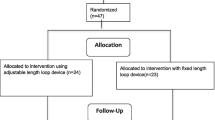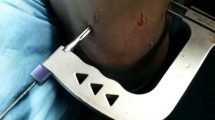Abstract
Purpose
Cortical femoral suspensory fixation using screw post in ACLR has the advantage of allowing complete filling of the femoral tunnel with graft tissue. In addition, the low cost of the implants is an advantage in countries where cost is an issue of concern. The purpose of the current study was to evaluate the clinical functional outcome results of cortical femoral suspensory fixation using screw post at mid-term follow-up.
Methods
Single surgeon single centre prospective case series study. Sixty two patients having complete ACL tears were included in the current study. Average follow-up was 52.6 months (range 38–68). Objective and subjective IKDC scores, Lysholm knee score, SF-36 score, VAS for patients’ satisfaction, VAS for pain and Kellgren & Lawrence (K/L) classification of osteoarthritis were used for follow-up evaluation.
Results
Objective IKDC score revealed that 59 patients had grade “A” and 3 had grade “B”, while no single patient had neither grade “C” nor “D”. The average Lysholm score was 90.7, average subjective IKDC was 89.5. Average SF-36 score was 94.8. The average VAS for operation satisfaction was 9.4. Average VAS for pain was 0.2. Forty six patients were classified as normal K/L classification, nine were grade “1”, seven were grade “2”. Comparing pre-operative and follow-up objective IKDC, subjective IKDC, Lysholm, SF-36, and VAS for pain scores revealed statistically significant differences (P-value <0.05).
Conclusion
Femoral suspensory fixation using screw post in ACLR showed excellent functional outcome results at mid-term follow-up.


Similar content being viewed by others
References
Ahmad CS, Gardner TR, Groh M et al (2004) Mechanical properties of soft tissue femoral fixation devices for anterior cruciate ligament reconstruction. Am J Sports Med 32(3):635–640
Matsumoto A, Yoshiya S, Muratsu H et al (2006) A comparison of bone patellar tendon-bone and bone-hamstring tendon-bone autografts for anterior cruciate ligament reconstruction. Am J Sports Med 34(2):213–219
Taylor DC, DeBerardino TM, Nelson BJ et al (2009) Patellar tendon versus hamstring tendon autografts for anterior cruciate ligament reconstruction: a randomized controlled trial using similar femoral and tibial fixation methods. Am J Sports Med 37(10):1946–1957
Ntagiopoulos PG, Demey G, Tavernier T, Dejour D (2015) Comparison of resorption and remodeling of bioabsorbable interference screws in anterior cruciate ligament reconstruction. Int Orthop 39(4):697–706
Scheffler SU, Sudkamp NP, Gockenjan A et al (2002) Biomechanical comparison of hamstring and patellar tendon graft anterior cruciate ligament reconstruction techniques: the impact of fixation level and fixation method under cyclic loading. Arthroscopy 18:304–315
Stadelmaier DM, Lowe WR, Ilahi OA et al (1999) Cyclic pullout strength of hamstring tendon graft fixation with soft tissue interference screws: influence of screw length. Am J Sports Med 27(6):778–783
Choi NH, Lee JH, Victoroff BN (2007) Do broken cross-pins compromise stability after anterior cruciate ligament reconstructions with hamstring tendons? Arthroscopy 23(12):1334–1340
Petre BM, Smith SD, Jansson KS et al (2013) Femoral cortical suspension devices for soft tissue anterior cruciate ligament reconstruction: a comparative biomechanical study. Am J Sports Med 41(2):416–422
Takeda Y, Iwame T, Takasago T et al (2013) Comparison of tunnel orientation between transtibial and anteromedial portal techniques for anatomic double-bundle anterior cruciate ligament reconstruction using 3-dimensional computed tomography. Arthroscopy 29(2):195–204
Kellgren JH, Lawrence JS (1957) Radiological assessment of osteoarthrosis. Ann Rheum Dis 16:494–501
Hefti F, Müller W, Jakob RP et al (1993) Evaluation of knee ligament injuries with the IKDC form. Knee Surg Sports Traumatol Arthrosc 1:226–234
Tegner Y, Lysholm J (1985) Rating systems in the evaluation of knee ligament injuries. Clin Orthop 198:43–49
Kalantar-Zadeh K, Kopple JD, Block G et al (2001) Association among SF-36 quality of life measures and nutrition, hospitalization and mortality in hemodialysis. J Am Soc Nephrol 12(12):2797–2806
Karlsson J, Irrgang JJ, van Eck CF et al (2011) Anatomic single- and double-bundle anterior cruciate ligament reconstruction, part 2: clinical application of surgical technique. Am J Sports Med 39:2016–2026
Abdelkafy A (2012) Protection of the medial femoral condyle articular cartilage during drilling of the femoral tunnel through the accessory medial portal in anatomic anterior cruciate ligament reconstruction. Arthrosc Tech 1(2):e149–e154
Andrei BI, Niculescu M, Popescu G (2015) Position of anterior cruciate ligament after single-bundle arthroscopic reconstruction. Int Orthop. doi:10.1007/s00264-015-2964-7
Ambra LF, Rezende FC, Xavier B, Shumaker FC, da Silveira Franciozi CE, Luzo MV (2015) Anterior cruciate ligament reconstruction: how do we perform it? Brazilian orthopedic surgeons’ preference. Int Orthop. doi:10.1007/s00264-015-2905-5
Mouzopoulos G, Siebold R, Tzurbakis M (2015) Hip flexion strength remains decreased in anterior cruciate ligament reconstructed patients at one-year follow up compared to healthy controls. Int Orthop 39(7):1427–1432
Shabani B, Bytyqi D, Lustig S, Cheze L, Bytyqi C, Neyret P (2015) Gait knee kinematics after ACL reconstruction: 3D assessment. Int Orthop 39(6):1187–1193
Rodeo SA, Arnocky SP, Torzilli PA et al (1993) Tendon healing in a bone tunnel: a biomechanical and histological study in the dog. J Bone Joint Surg Am 75(12):1795–1803
Wascher DC, Markolf KL, Shapiro MS et al (1993) Direct in vitro measurement of forces in the cruciate ligaments, part 1: the effect of muliplane loading in the intact knee. J Bone Joint Surg Am 75:377–386
Sundararajan SR, Rajagopalakrishnan R, Rajasekaran S (2015) Is height the best predictor for adequacy of semitendinosus-alone anterior cruciate ligament reconstruction? A study of hamstring graft dimensions and anthropometric measurements. Int Orthop. doi:10.1007/s00264-015-2882-8
Miyata K, Yasuda K, Kondo E et al (2000) Biomechanical comparisons of anterior cruciate ligament reconstruction procedures with flexor tendon graft. J Orthop Sci 5:585–592
Barrow AE, Pilia M, Guda T et al (2014) Femoral suspension devices for anterior cruciate ligament reconstruction: do adjustable loops lengthen? Am J Sports Med 42(2):343–349
Brucker PU, Lorenz S, Imhoff AB (2006) Aperture fixation in arthroscopic anterior cruciate ligament double-bundle reconstruction. Arthroscopy 22(11):1250.e1–1250.e6
Author information
Authors and Affiliations
Corresponding author
Ethics declarations
Authors certify that all procedures performed in the current study involving human participants were in accordance with the ethical standards of the institutional and national research committee and with the 1964 Helsinki declaration and its later amendments or comparable ethical standards.
Conflict of interest
None.
Rights and permissions
About this article
Cite this article
Abdelkafy, A. Cortical femoral suspensory fixation using screw post in anatomic single-bundle anterior cruciate ligament reconstruction: a prospective study and mid-term outcome results. International Orthopaedics (SICOT) 40, 1741–1746 (2016). https://doi.org/10.1007/s00264-015-3091-1
Received:
Accepted:
Published:
Issue Date:
DOI: https://doi.org/10.1007/s00264-015-3091-1




